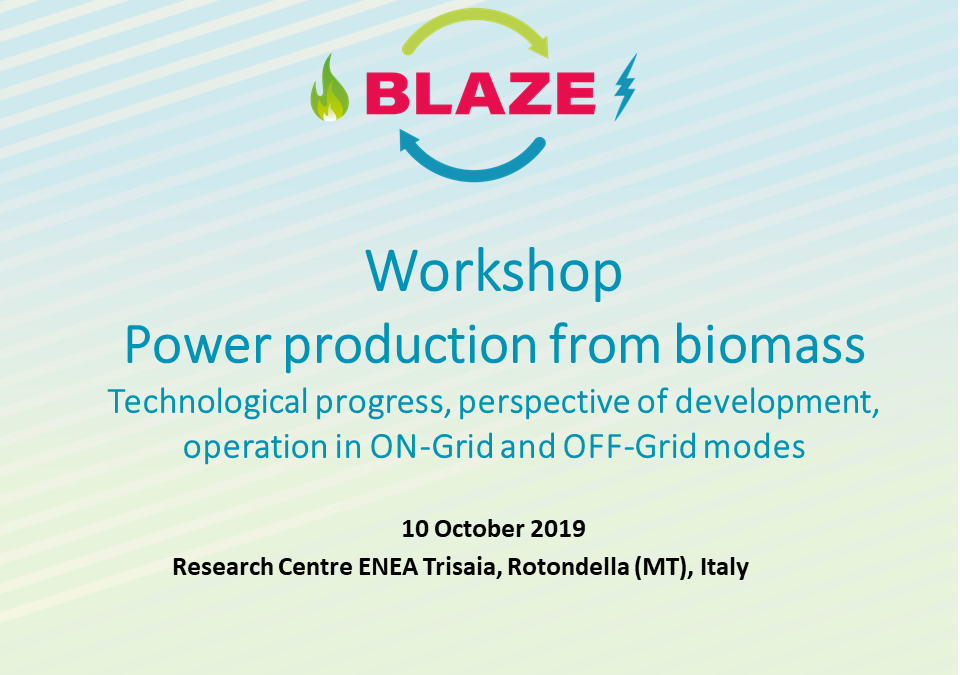Technological progress, perspective of development, operation in ON-Grid and OFF-Grid modes
Residual biomass is undoubtedly a resource that can be used for energy purposes. Its proper use can meet sustainability and environmental impact criteria as well as contribute to the achievement of the energy targets proposed by the EU strategies by 2030 and 2050. Suitable for both the production of heat and electricity with conventional combustion technologies, important R&D programs have been promoted in order to develop more efficient and economical production processes and supply chains, aimed at exploiting residual biomass for electricity production. Among the various technologies explored, gasification has certainly attracted remarkable attention for its potential to combine technical and scientific aspects with environmental and sustainability issues.
At EU level, the actions promoted, including those to support production costs with incentive policies, have enabled certain gasification technologies to reach the industrialization and commercialization stage. These are technologies suitable in particular to produce electricity in the small to medium range, i.e. in support of the decentralized energy production model, thus favoring the integration of a share of the production of electricity from biomass in the national grids of different European countries.
The experience gained through the operation of these technologies, the adjustment to specific efficiency targets, typically linked to the use of internal combustion engines for power production, together with technical-economic evaluations, lead to evaluate that, unlike what happened for technologies based on other renewable sources, gasification results in higher investment and management costs.
Thus the need to go further, to continue to innovate and improve in order to be able to reach an alignment of the costs of producing power from biomass with those achieved by technologies based on other renewable energy sources, such as hydro, photovoltaic and wind. Key elements to achieve this result in the case of gasification are the ability to develop technologies as flexible as possible with respect to the type of residual biomass feedstocks to be used and capable of leading to significant increases in plant productivity, both in terms of electrical and thermal efficiency, as well as of the annual producibility.
Funded within the EU Horizon 2020 programme, the BLAZE project aims to achieve these targets and, through the integration of gasification in fluidized beds with solid oxide fuel cells (SOFC), seeks to develop an advanced and zero emissions technology for cogeneration (CHP) by using low-cost biomass and from short chain. Reference range for power production, the sizes from small (25-100 kWe) to medium (0.1-5 MWe).
The project has also the ambition to achieve investment and operating costs of about 4k€/kWe and 0.05€/kWh respectively, high energy efficiencies (50% electricity over the current 20%), near zero gaseous and PM emissions. Electricity production costs of less than 0.10€/kWh. Starting from the specific aims of the BLAZE project, this workshop takes the opportunity to bring to the same table the most recent European projects focused on the subject, as well as experts on related issues, to compare their experiences and points of view through which trigger profitable synergies not only on the technological side, but also in perspective and strategic vision.
Agenda
8:30-8:45 Welcome and Opening of the sessions
8:45-9:00 The BLAZE project for the efficient power production from residual biomass feedstocks
09:00-11.00 Overview of related EU projects
FlexiFuel-SOFC – Development of a new and highly efficient micro-scale CHP system based on fuel-flexible gasification and a SOFC (Windhager Zentralheizung Technik Gmbh)
HiEff-BioPower – Development of a new highly efficient and fuel flexible medium-scale CHP technology based on fixed-bed updraft biomass gasification and a SOFC (BIOS BIOENERGIESYSTEME GMBH)
Bio-CCHP – Advanced biomass CHP based on gasification, SOFC and cooling machines (Graz University of Technology)
Waste2Grids – Converting WASTE to offer flexible GRID balancing services with highly integrated efficient solid-oxide plants project (Ecole Politecnique Fédéral de Lausanne)
Waste2Watts – Unlocking unused bio-WASTE resources with loW cost cleAning and Thermal inTegration with Solid oxide fuel cells (Ecole Politecnique Fédéral de Lausanne)
DEMOSOFC – Design and installation of a 175 kWe Solid Oxide Fuel Cell plant (Politecnico di Torino)
SOFCOM – SOFC CCHP with poly-fuel: operation and management (Politecnico di Torino)
11:00 Coffee break
11:15-12:15 – Policies strategies and regulatory aspects
Biomass target 2030/2050 for small and medium cogeneration (SET Plan Implementation Working Group 8, F. Cotana)
The strategic role of forest and agro-forestry biomass in the production of heat and power (Italian Biomass Industry Association)
The power production from biomass in distributed generation scenarios (RdSE, Ricerca di sistema elettrico)
Bioenergy as a sustainable solution for the exploitation of residual biomass (IEA BIO-ENERGY, V. Pignatelli)
12:15-12:45 Discussion
12:45 -13:15 Workshop Summary and Closing remarks
13:30 Lunch at CR Trisaia Cafeteria


Recent Comments